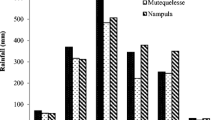Summary
Previous laboratory and greenhouse studies have shown that phages significantly reduce soil populations of homologous rhizobia. Reductions in nodulation and N2 fixation have also been observed. The purpose of the current study was to examine the effect of a phage specific ofBradyrhizobium japonicum USDA 117 on nodulation, nodule occupancy, N2 fixation and soybean growth and yield under field conditions. The phage was inoculated in combination withB. japonicum USDA 117 and/orB. japonicum USDA 110 (resistant strain) into a rhizobia-free sandy loam soil and planted toGlycine max (L.) Merr. “Williams”. When the phage was applied to soil inoculated withB. japonicum USDA 117 alone, significant reductions in nodule weight and number, shoot weight, foliar N, nitrogenase activity, and seed index were observed. When, however, the soil also contained the non-homologous strain,B. japonicum USDA 110, no significant effects on any of these parameters were found. Nodule occupancy by competing strains ofB. japonicum USDA 110 and USDA 117 was also affected by the phage. In soil which did not contain the phage, 46% and 44% of the identified nodules were occupied by USDA 110 and 117, respectively. When the phage was present in the soil, nodule occupancy byB. japonicum USDA 117 was reduced to 23%, while occupancy byB. japonicum USDA 110 was increased to 71%. These results suggest that nodulation by selected strains of rhizobia can be restricted and nodulation by more effective, inoculated strains can be increased through the introduction of a homologous phage to soils.
Similar content being viewed by others
References
Almond L, Wilson PW (1933) Bacteriophage in relation to nitrogen fixation by red clover. Arch Mikrobiol 4:209–219
Bradstreet RB (1965) The Kjeldahl method for organic nitrogen. Academic Press, New York
Burch CW, Allen ON (1955) Description of two bacteriophages active against lotus rhizobia. Soil Sci Soc Am J 19:175–179
Burns RC, Hardy RW (1975) Nitrogen fixation in bacteria and higher plants. Springer, Berlin
Demolon A (1951) Contribution à l'étude de la symbiose bactérienne chez les legumineuses. Rev Gen Bot 58:562
Demolon A, Dunez A (1935) Recherches sur le role du bacteriophage dance fatigue des luzernières. Ann Agron 5:89–111
Demolon A, Dunez A (1936) Nouvelles observations sur le bacteriophage et le bacteriophage et la fatigue des sols cultivées en luzerne. Ann Agron 6:434–454
Dhar DB, Singh RB, Singh RM, Singh VP, Srivastava J (1978) Isolation and characterization of a virus (RL1) ineffective onRhizobium leguminosarum. Arch Microbiol 119:263–269
Dhar B, Singh BD, Singh RB, Srivastava JS, Singh VP, Singh RM (1979) Occurrence and distribution of rhizobiophages in Indian soil. Acta Microbiol Pol 28:319–324
Dhar B, Ramkrishna K, Singh DB, Singh RM (1987) Morphology and biological properties of phage RL4 ofRhizobium leguminosarum SU 391. Indian J Exp Biol 25:38–41
Evans J, Barnet YM, Vincent JM (1979a) Effect of bacteriophage on colonization and nodulation of clover roots by strain ofRhizobium trifolii. Can J Microbiol 25:974–978
Evans J, Barnet YM, Vincent JH (1979b) Effect of bacteriophage on colonization and nodulation of clover roots by paired strains ofRhizobium trifolii. Can J Microbiol 25:974–978
Goodnight JH (1982) The ANOVA procedure. In: SAS user's guide —Statistics. SAS Institute, Cary, North Carolina, pp 119–138
Gupta BM, Klecwzkowska W (1962) A study of some mutants in a strain ofRhizobium trifolii. J Gen Microbiol 27:474–476
Hashem FM, Angle JS (1988) Rhizobiophage effects onBradyrhizobium japonicum nodulation and soybean growth. Soil Biol Biochem 20:69–73
Hashem FM, Angle JS, Ristiano PA (1986) Isolation and characterization of rhizobiophage specific forRhizobium japonicum USDA 117. Can J Microbiol 32:326–329
Hickey WJ, Loynachan TE, Ayanaba A, Zablotowicz RM (1987) Diversity within IowaBradyrhizobium japonicum serogroup 123. Soil Sci Soc Am J 51:941–946
Klecwzkoska J (1950) A study of phage-resistant mutants ofRhizobium trifolii. J Gen Microbiol 4:298–310
Kowalski M (1966) Lysogeny inRhizobium meliloti. Acta Microbiol Pol 15:119–128
Kowalski M, Ham GH, Frederick LR, Anderson TC (1974) Relationship between strains ofRhizobium japonicum and their bacteriophages from soil and nodules of field-grown soybeans. Soil Sci 118:221–228
Marques-Pinto C, Yao CP, Vincent JM (1974) Nodulating competitiveness among strains ofRhizobium meliloti andR. trifolii. Aust J Agric Res 25:317–329
Vidor C, Miller RH (1980) Relative saprophytic competence ofRhizobium japonicum strains in soils as determined by the quantitative fluorescent antibody technique (FA). Soil Biol Biochem 12:483–487
Vincent JM (1970) A manual for the study of root nodule bacteria. Blackwell, Oxford
Vincent JH (1977)Rhizobium: General microbiology. In: Hardy RWF, Silver WS (eds) A treatise on nitrogen fixation, vol 3. John Wiley, New York
Author information
Authors and Affiliations
Rights and permissions
About this article
Cite this article
Hashem, F.M., Angle, J.S. Rhizobiophage effects on nodulation, nitrogen fixation, and yield of field-grown soybeans (Glycine max L. Merr.). Biol Fertil Soils 9, 330–334 (1990). https://doi.org/10.1007/BF00634110
Received:
Issue Date:
DOI: https://doi.org/10.1007/BF00634110




